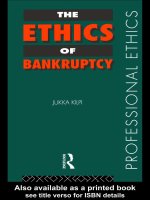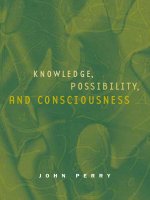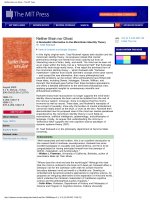the mit press ethics of the body postconventional challenges jun 2005
Bạn đang xem bản rút gọn của tài liệu. Xem và tải ngay bản đầy đủ của tài liệu tại đây (1.5 MB, 301 trang )
THE BODY
Margrit Shildrick and
Roxanne Mykitiuk
ETHICS OF
edited by
bioethics
Ethics of the Body
Postconventional Challenges
edited by Margrit Shildrick and Roxanne Mykitiuk
The provocative contention of the postmodernist and feminist essays in
Ethics of the Body is that
conventional bioethics is out of touch, despite its growing profile. It is out of touch with an ongoing
phenomenological sense of bodies themselves; with the impact of postmodernist theory as it prob-
lematizes the certainties of binary thinking; and with a postmodern culture in which bioscientific
developments force us to question what is meant by the notion of the human self. The authors demon-
strate that the conventional normative framework of bioethics is called into question by issues as wide
ranging as genetic manipulation, disability, high-tech prosthetics, and intersexuality. The essays show
how both the theory and practice of bioethics can benefit from postmodernism’s characteristic fluid-
ity and multiplicity, as well as from the insights of a reconceived feminist bioethics. They address
issues in philosophy, law, bioscientific research, psychiatry, cultural studies, and feminism from a
“postconventional” perspective that looks beyond the familiar ideas of the body, proposing not a
bioethics about the body but a radical ethics of the body.
After exploring notions of difference in both feminist and postmodernist terms, the book con-
siders specific issues—including HIV, addiction, borderline personality disorder, and cancer—that chal-
lenge the principles of conventional bioethics. The focus then turns to questions raised by biotech-
nology: one essay rethinks the traditional feminist ethics of care in the context of new reproductive
technology, while others tackle genetic and genomic issues. Finally, the book looks at embodiment
and some specifically anomalous forms of being-in-the-body, including a consideration of intersex
infants and children that draws on feminist, poststructuralist, and queer theory.
Margrit Shildrick is Senior Research Visiting Fellow at WERRC, University College Dublin. Roxanne
Mykitiuk is Associate Professor of Law at Osgoode Hall Law School at York University, Toronto.
Basic Bioethics series
“Rather than merely applying established concepts of ethics to biomedical problems,
Ethics of the
Body puts the field of ethics itself in question. These essays demonstrate how the challenges and
crises posed by advances in biomedicine require nothing less than new concepts of moral agency
and responsibility beyond the conventional models of consequentialism, deontology, and virtue.
Drawing on diverse resources—phenomenology, Derrida’s thought of
différance, Foucault’s critique of
power, and Irigaray’s radical feminism—the contributors inaugurate a critical reconfiguring of the eth-
ical subject, while at the same time they offer concrete and original approaches to particular moral
problems in medicine and biotechnology. Anyone working in ethics or bioethics needs to confront the
conceptual and practical challenges posed by this volume.”
—Mary C. Rawlinson, Department of Philosophy, Stony Brook University
“A remarkable group of essays that use postmodern thought to deconstruct conventional bioethics,
biomedicine, and biotechnology. Shildrick and Mykitiuk succeed in convincing readers that for all its
difficulties, postmodern thought is probably best suited to confront humanity’s growing awareness of
human difference. This book will be a significant contribution to bioethics.”
—Rosemarie Tong, Department of Philosophy and Center for Professional and Applied Ethics,
University of North Carolina at Charlotte
“This is an exciting and challenging collection of essays. They ought to convince even the most skep-
tical bioethicist that postmodernist bioethics can produce radical illuminations and reflective theoriz-
ing regarding the diversity and fluidity of human embodiment that marks the twenty-first century. The
lucid introduction and the compelling range of essays offer critical and substantive insights into the
bioethical dilemmas and choices we face as embodied individuals, as human community, and as a
species whose future is uncertain.”
—Kathryn Pauly Morgan, Professor of Philosophy, Women’s Studies, and Bioethics, University of
Toronto
Cover art: Louise Bourgeois, Arch of Hysteria, 2000. Hanging Piece: Pink Fabric,
5 1/2 x 17 1/2 x 11 inches; 13.9 x 44.4 x 27.9 cm. Courtesy Galerie Karsten Greve, St. Moritz.
Photo: Christopher Burke
The MIT Press
Massachusetts Institute of Technology
Cambridge, Massachusetts 02142
ETHICS OF THE BODY
Shildrick and Mykitiuk, editors
,!7IA2G2-gjdcac!:t;K;k;K;k
0-262-69320-8
Postconventional Challenges
Ethics of the Body
04447_Prelims.qxd 3/24/05 12:50 AM Page i
Basic Bioethics
Glenn McGee and Arthur Caplan, editors
Pricing Life: Why It’s Time for Health Care Rationing,
Peter A. Ubel
Bioethics: Ancient Themes in Contemporary Issues,
edited by Mark G. Kuczewski and Ronald Polansky
The Human Embryonic Stem Cell Debate: Science, Ethics,
and Public Policy,
edited by Suzanne Holland, Karen Lebacqz, and Laurie Zoloth
Engendering International Health: The Challenge of Equity,
edited by Gita Sen, Asha George, and Piroska Östlin
Self-Trust and Reproductive Autonomy,
Carolyn McLeod
What Genes Can’t Do,
Lenny Moss
In the Wake of Terror: Medicine and Morality in a Time of Crisis,
edited by Jonathan D. Moreno
Pragmatic Bioethics, 2d edition,
edited by Glenn McGee
Case Studies in Biomedical Research Ethics,
Timothy F. Murphy
Genetics and Life Insurance: Medical Underwriting and Social Policy,
edited by Mark A. Rothstein
Ethics and the Metaphysics of Medicine: Reflections on Health and
Beneficence,
Kenneth A. Richman
DNA and the Criminal Justice System: The Technology of Justice,
edited by David Lazer
Is Human Nature Obsolete? Genetics, Bioengineering, and the Future of the
Human Condition,
edited by Harold W. Baillie and Timothy K. Casey
End of Life Decision-Making: A Cross-National Study,
edited by Robert H. Blank and Janna C. Merrick
Deciding for the Profoundly Mentally Disabled,
by Norman L. Cantor
Ethics of the Body: Postconventional Challenges,
edited by Margrit Shildrick and Roxanne Mykitiuk
04447_Prelims.qxd 3/24/05 12:50 AM Page ii
Ethics of the Body
Postconventional Challenges
edited by Margrit Shildrick and Roxanne Mykitiuk
The MIT Press
Cambridge, Massachusetts
London, England
04447_Prelims.qxd 3/24/05 12:50 AM Page iii
©2005 Massachusetts Institute of Technology
All Rights Reserved. No part of this book may be reproduced in any form by
any electronic or mechanical means (including photocopying, recording, or
information storage and retrieval) without permission in writing from the pub-
lisher.
MIT Press books may be purchased at special quantity discounts for business or
sales promotional use. For information, please email
or write to Special Sales Department, The MIT Press, 5 Cambridge Center,
Cambridge, MA 02142.
This book was set in Sabon by Achorn Graphic Services, Inc.
Printed on recycled paper and bound in the United States of America.
Library of Congress Cataloging-in-Publication Data
Ethics of the body: postconventional challenges / edited by Margrit Shildrick and
Roxanne Mykitiuk.
p. cm.—(Basic bioethics)
Includes bibliographical references and index.
ISBN 0-262-19523-2 (alk. paper)—ISBN 0-262-69320-8 (pbk. : alk. paper)
1. Bioethics. I. Shildrick, Margrit. II. Mykitiuk, Roxanne, 1962– III. Series.
QH332.E736 2005
174′.957—dc22
2004061361
10987654321
04447_Prelims.qxd 3/24/05 12:50 AM Page iv
Contents
Series Foreword vii
Acknowledgments ix
I Introduction
1 Beyond the Body of Bioethics: Challenging the Conventions 1
Margrit Shildrick
II Critical Differences
2 Attending to Difference: Phenomenology and Bioethics 29
Philipa Rothfield
3 Admitting All Variations? Postmodernism and Genetic
Normality 49
Jackie Leach Scully
III Thinking Through Crisis
4 The Measure of HIV as a Matter of Bioethics 71
Marsha Rosengarten
5 Addiction and the Bioethics of Difference 91
Helen Keane
6 Liberatory Psychiatry and an Ethics of the In-Between 113
Nancy Potter
7 A Bioethics of Failure: Antiheroic Cancer Narratives 135
Lisa Diedrich
IV The Challenge of Biotechnology
8 Biomedicine and Moral Agency in a Complex World 155
Sylvia Nagl
04447_Prelims.qxd 3/24/05 12:50 AM Page v
9 Reproductive Technology and the Political Limits of Care 175
Carol Bacchi and Chris Beasley
10 Genetics and the Legal Conception of Self 195
Isabel Karpin
11 The Devouring: Genetics, Abjection, and the Limits of Law 217
Karen O’Connell
V Rethinking the Materiality of Embodiment
12 A “Genethics” That Makes Sense: Take Two 237
Rosalyn Diprose
13 Queer Kids: Toward Ethical Clinical Interactions with Intersex
People 259
Katrina Roen
Contributors 279
Index 281
vi Contents
04447_Prelims.qxd 3/24/05 12:50 AM Page vi
Series Foreword
We are pleased to present the sixteenth book in the series Basic Bioethics.
The series presents innovative works in bioethics to a broad audience and
introduces seminal scholarly manuscripts, state-of-the-art reference works,
and textbooks. Such broad areas as the philosophy of medicine, advanc-
ing genetics and biotechnology, end-of-life care, health and social policy,
and the empirical study of biomedical life are examined.
Glenn McGee
Arthur Caplan
Basic Bioethics Series Editorial Board
Tod S. Chambers
Susan Dorr Goold
Mark Kuczewski
Herman Saatkamp
04447_Prelims.qxd 3/24/05 12:50 AM Page vii
04447_Prelims.qxd 3/24/05 12:50 AM Page viii
Acknowledgments
As with any intellectual enterprise, many friends and colleagues have
contributed both knowingly and unknowingly to the generation and com-
pletion of this collection. Some have been encouraging, others skeptical,
but all have had an influence. The initial idea came about as the result
of a kind invitation from Anne Donchin independently to both editors
to take part in a panel for the third International Conference of Feminist
Approaches to Bioethics (FAB) held in London in 2000. Although Anne
and other members of the executive committee of FAB had hoped
we would edit a collection of papers drawn from that conference, we
decided instead on a different approach that more clearly reflected our
own postmodernist interests. Nonetheless, we sincerely hope that they
will find this book both surprising and stimulating. Our main thanks,
then, to the present contributors—of whom just two presented papers in
London—for their enthusiasm, support, and patience throughout a some-
what lengthy process.
Margrit: my personal thanks to Roxanne for making this long-distance
collaboration such a pleasurable and care-free experience and to my long-
term collaborator Janet Price, whose sharing and discussion of ideas over
many years remains invaluable.
Roxanne: Misha Mykitiuk has been a patient and understanding child
during the completion of this project. I am also grateful to Margrit for
her good-humored patience and perseverance.
04447_Prelims.qxd 3/24/05 12:50 AM Page ix
04447_Prelims.qxd 3/24/05 12:50 AM Page x
I
Introduction
04447_Prelims.qxd 3/24/05 12:50 AM Page xi
04447_Prelims.qxd 3/24/05 12:50 AM Page xii
1
Beyond the Body of Bioethics: Challenging
the Conventions
Margrit Shildrick
As a recognizable and credible discipline entitled to comment, guide, and
pass judgment on the broad operation of biomedicine, bioethics has
become fully established only during the past few decades. Taking in
aspects both of ethics in general—with a particular focus on the practi-
calities of applied morality—and of relevant legal tenets, the discipline
has recently emerged as the source of authoritative evaluation for a range
of biomedical issues covering not only the behavior and practice of pro-
fessional providers and users of health care systems but also bioscientific
research and development. At the same time, contemporary bioethicists
are increasingly expected to participate in the public debate about what
are broadly seen as biomedical dilemmas, particularly those arising from
the new technologies. They are called on to resolve problems, to adjudi-
cate between rival opinions or suggested courses of action, and above all,
to lend the imprimatur of the moral good to this or that decision, usu-
ally without recourse to too much high theory.
The primary issues of concern to bioethicists are taken to be the prag-
matic ones that in one way or another make a direct difference in how
biomedicine conducts itself. Although there is always a place for explo-
ration of the theoretical frameworks—the metaethics—that support or
preclude the relevance of any one model of behavior, the real test of
bioethics is whether it is able to operate adequately in practice. In other
words, the question is one of the extent to which it answers the different
needs and desires of individual agents faced with a complexity of possi-
ble courses of action, and uncertain as how to proceed for the best result.
Nonetheless, it is our contention in this book that despite such worthy
aims, and for all its high profile, bioethics is out of touch. It is out of
04447_Ch01.qxd 3/2/05 10:07 AM Page 1
touch with bodies themselves, in the phenomenological sense in which
the being, or rather the becoming, of the self is always intricately inter-
woven with the fabric of the body; it is out of touch with the develop-
ments in and impact of postmodernist theory as it problematizes the
hitherto unchallenged certainties of binary thinking; and it is out of
touch with a postmodern culture in which bioscience itself forces us to
question what is meant by the notion of the human self.
The publicly acknowledged and newly persuasive status of bioethics
in the twenty-first century—in the West at least—can be no surprise to
those aware of the transformatory changes in biomedical practice that
have taken place during the past few decades. In the areas both of lay
opinion, in which the media play no small part, and of specialist con-
cerns, there is a growing awareness that decisions made in the field of
bioscience have far-reaching effects. They not only relate to traditional
concerns with the direct operative possibilities of any health care deliv-
ery, but more fundamentally they question some of the taken-for-granted
parameters of what it means to be a human being. Issues of where the lim-
its of reproduction lie, what constitutes a “normal” body, whether species
distinction should be rigidly maintained, how to determine the bound-
aries of life and death, the value of individuality, and many other equally
urgent and troubling concerns, have entered public discussion. Although
the power of biomedical discourse to shape as well as to respond to
social norms, needs, and desires has long been recognized, there has been
relatively little long-term dissent from the view that an expanded under-
standing of the human body equates unproblematically with progress.
Religious teaching and popular prejudice alike have periodically railed
against certain developments such as postmortem examination, the use
of blood transfusions, or more recently the introduction of effective con-
traception for women, but for the majority, the successful application of
such techniques has rapidly led to their acceptance. They are plainly seen
to do good, to advance, in other words, what we understand to be the
paradigm of health. It is too soon to know whether current innovations
in the knowledge base of bioscience will in turn come to be seen as a self-
evident good, but what is perhaps different in the process is the expecta-
tion that particular “experts” in moral reasoning—bioethicists—will be
able to guide evaluation in the direction of clear and distinct answers.
2 Margrit Shildrick
04447_Ch01.qxd 3/2/05 10:07 AM Page 2
The difficulty as I see it—and it is one that bioethicists themselves have
largely failed to address—is that the desire to distinguish between right
and wrong, between good and bad actions, or to have a determinate
assessment of consequences remains undiminished in the face of a set of
developments that are marked by their problematization of normative,
oppositional, binaries. In other words, in the period we might term the
era of postmodernity, precisely our own time, the problems created by a
bioscience that has become highly technological, with its ever-accelerating,
expanding, and unpredictable datasets, are intrinsically unfamiliar. Yet
there is a strong tendency to continue to rely on models of moral evalu-
ation that derive from a belief in fixed and normative templates as
adequate for all new knowledge. The argument is that although under-
standing of the body might vary, the ontology of being human, of having
potentially fixed standards of judgment, and thus of proper or improper
moral agency, does not. This conventional morality relies predominantly
on such qualities of mind as rationality, self-sovereignty, and impartiality,
and although bioethics—with its putative focus on the practices of the
body—might be expected to break with such abstraction and offer
a more dynamic model, there is little sign of such a change. Instead, the
discipline has effectively duplicated the master discourse and maintained
the split between a secure sense of the transcendent self as moral agent,
and a more or less unruly body that must be subjected to its dictates.
Even in the era of postmodernity where no such certainties about the
nature of the human self can endure, bioethics clings to the familiar
philosophical models of consequentialism, with its confidence in a deter-
minable calculus of harms and benefits, to deontology with its fixed prin-
ciples of right and wrong action, or to the notion of virtue where what
counts is precisely human flourishing.
While it is not my argument that there is no place at all for certain con-
ventional moral and legal judgments—for they continue to act as practi-
cal safeguards against the abuse of biomedical power—I prefer to see
them as second-order considerations. Rather than simply outlining a set
of moral precepts geared to the delivery of a working relationship
between the needs and desires of those involved in biomedicine and some
concept of the good, the contributors to this book believe it is the task
of bioethicists to step back and ask whether the ethical frameworks
Beyond the Body of Bioethics 3
04447_Ch01.qxd 3/2/05 10:07 AM Page 3
inherited from modernist discourse are adequate for the developments of
a postmodern age, in both its theoretical and practical contexts. The
latter is perhaps easier to appreciate in that it is a common observation
that the pace of actual and potential innovation in the biosciences has
accelerated far beyond anything that the ethical imagination has antici-
pated. That in itself has created an impossible pressure on the efficacy
and adequacy of modernist conventions that are ill-adapted to take
account of the new contingencies. Even philosophers well versed in the
use of arcane thought experiments must struggle to apply the familiar
paradigms of western ethics to scenarios that fundamentally contest
normative conceptions of biology and of human life. I am thinking here
of issues such as persistent vegetative state, prenatal gene manipulation,
cloning, and even the growing use of high-tech prosthetics. The concern,
then, is not so much to debate what changes and reforms could be made
to existing moral precepts, but to ask what difference it would make to
accept that the issues raised by the potential to vary the conditions of
reproduction, of life or death, of embodiment, and indeed of human
being itself, are ones that demand a radical reconfiguration of bioethical
thought. The suggestion, developed throughout this volume, is that the
issues would be better addressed by a postconventional or postmodernist
approach that specifically seeks to break down such binary categories as
those of the normal and the abnormal, of health and illness, of self and
other, which are the bases of normative bioethics.
What then are the key features of the approach we favor? Post-
modernism is itself a notoriously slippery term, and it should be clear
from the start that my purpose is not to attempt to pin it down to a few
definitive points, but to make use of some of its facets that lend them-
selves to rethinking an ethics of the body. Moreover, it is debatable
whether all postconventional theory could be seen as postmodern.
Feminism, for example, clearly rejects many of the conventions of mod-
ernism without necessarily engaging in a radical critique of the funda-
mental structure of western thought. For the purposes of this volume,
however, it is just such a radical move, which goes far beyond the possi-
bility of simply reforming existing systems, that concerns us, and to that
end the contributors employ critiques that could be termed phenomeno-
logical, poststructuralist, deconstructionist, or postmodernist. What all
4 Margrit Shildrick
04447_Ch01.qxd 3/2/05 10:07 AM Page 4
these approaches have in common is that they contest the grounding
certainties of the modernist project, particularly as it is manifest in the
form of liberal humanism.
That system, which has been dominant in the West since the seventeenth-
century Enlightenment, is characterized by a moral and social order in
which autonomous individuals—supposedly neutral with respect to gen-
der and race, for example—have sovereignty over their own lives, and
enter into contractual relations with other similarly sovereign individu-
als, on the basis of free will and rationality. They are immediately recog-
nizable as the normative agents—the actors—of conventional moral
and bioethical theory. The specifically liberal humanist qualities of liberty,
equality, rights, duties, and impartiality are then at the heart of the
convention. Moreover, in that same intellectual tradition, all categories
of thought, knowledge itself, are organized according to a thoroughgo-
ing system of binary opposites that set in place unequivocal distinctions
between self and other, mind and body, subject and object, right and
wrong, truth and falsity, human and animal, health and disease, natural
and artificial, and so on. In such a brief account some oversimplification
is inevitable, but the point is that in its ideal form, it is a system that
allows little in the way of uncertainty, mutability, or provisionality. In
terms of an ethical application, it lends itself—indeed demands—clarity
and resolution.
In contrast, the perspectives that fall under the umbrella term of
“postmodernism” challenge and disrupt the foundations of mainstream
western thought in a variety of ways. Their claim is that the rationalist
and scientific project that characterized the European Enlightenment,
with its appeal to the notion of progress and an ever-growing body
of certain knowledge, is at an end. In place of a fixed and coherent
notion of “truth,” there are only multiple and provisional “truths,”
a series of dispersed and possibly conflicting discourses, none of which
can claim ultimate authority. In consequence, because the notion of
a unified rationality is fragmented, the so-called “grand narratives”
of western thought—liberal humanism, including the discourses of
bioscience and the law, and even conventional morality itself—have no
enduring power. At the same time, the boundaries between the suppos-
edly discrete categories by which thought is organized—natural and
Beyond the Body of Bioethics 5
04447_Ch01.qxd 3/2/05 10:07 AM Page 5
artificial would be a pertinent example—are shown to be blurred and
leaky. Instead of the certainty of the separation and distinction of binary
pairs that allowed a hierarchical ordering of value, and in which one
term was consistently dominant, simple difference is replaced not just by
multiple differences, but what Derrida (1973) calls différance, in which
no term has independent meaning or value. Rather, there is an over-
flowing and intermingling of categories, a mutual dependence that belies
the traditional insistence on clear and distinct divisions. Moreover,
nothing is fixed in essence or given in advance of its representation;
on the contrary, insofar as it is constructed through a tissue of mobile
differences, meaning is fully discursive. This radical problematization of
the known—what is often referred to as deconstruction—is as much a
matter of the ontology of the subject as it is of epistemic categories. It is
not simply that the binary of self and other is disrupted, but that the
self, as a unified and identifiable entity, does not precede its own dis-
cursive construction. In other words, there is no sovereign subject, no
central arbiter of truth or authority, no preexisting agent of moral
action.
When it comes to the materiality of the body, postconventional and
deconstructionist approaches are no less radical. In place of the implicit
Cartesian split between mind and body, which is just one of the central
binaries that is shown to be untenable, the notion of embodiment is
employed to express an intertwining of the two elements. Rather than
a traditional model in which the transcendent mind is unconstrained
by the immanent flesh, at least insofar as the subject is white and mas-
culine, the subject’s very being—or more accurately, becoming—is
dependent on the body. It is not simply a matter of having or owning
a body, or of using it as an instrument, where the subject might yet be
seen as a controlling overseer, but one in which embodiment is the
condition of being a self at all. Just as that self is never separable from
its own materiality, it is also not fully separable from other embodied
selves. In postmodernist thought, the categorical distinctions among
bodies are not natural givens, as bioscience has traditionally insisted, but
normativities imposed and maintained by a combination of disciplinary
and regulatory controls, not least of which is the practice of biomedicine
itself. The extent of the control required to prop up such normative
6 Margrit Shildrick
04447_Ch01.qxd 3/2/05 10:07 AM Page 6
categories is readily apparent in at least two issues addressed in subse-
quent chapters: the treatment of intersexuality and the potential genetic
limitation of disability. Against the inherent failure of the modernist
model in which each form is bounded and self-complete, the postmod-
ernist claim is that all corporeality is inherently leaky, uncontained, and
uncontainable (Shildrick 1997). In other words, morphology is not some-
thing given once and for all, but is a process without an end.
The implications for a conventional understanding of the body, and by
extension any material interaction with it, are far-reaching. The ideal
configurations around which western thought is organized are exposed
as precisely that—simply flawless templates that the bodies of everyday
life more or less approximate, and are more or less valued as a conse-
quence. All evidence of the actual instabilities, imperfections, break-
downs, and sheer messiness of corporeality—the very things that might
be the subject of bioethics—is seen as a failure of form, a lack of whole-
ness and integrity, that is pushed to the margins as different or is even
disavowed. In the cultural imaginary, the manifestation of lack as a
material condition of bodies causes great anxiety and must be kept out
of touch lest it undermine the security of the supposedly normatively
embodied subject (Shildrick 2002). Yet although our overriding concern
is to buttress our sense of unity and autonomy—the cherished attributes
of the modernist subject—by centering on what Julia Kristeva has called
“the self’s clean and proper body” (1982: 71), that other body always
returns. In disability and disease, in dreams, in reproduction and preg-
nancy, in growing old, in sexual practice, in cybernetics and genetic
manipulation, the body transgresses its normative boundaries and draws
attention to its own constructionist dynamic. Indeed, it is just such a
scenario that Karen O’Connell (chapter 11) describes in her reflections
on the limits of the body in law. Underlying our individual and cultural
investments in order and distinction, then, underlying the normative
exclusions and denial that so often are apparent in a reluctance to touch,
another less comforting and far less determinate picture emerges.
What this means in terms of ethical transactions is that the encounter
between one and another might be modelled on something other than
autonomous abstract entities negotiating the safe space of separation and
distinction. Instead, the interval is dissolved, and as embodied selves,
Beyond the Body of Bioethics 7
04447_Ch01.qxd 3/2/05 10:07 AM Page 7
who are not just interdependent but whose morphology is without di-
visive boundaries, the self and other are opened up to one another in a
relationship in which the metaphorics of touch can play a primary part.
One clear way in which this has been taken up in ethics is through the
phenomenology of Merleau-Ponty (1962, 1968), who insists that the self
and every other materiality is constituted in mutual relation. For Merleau-
Ponty, there is no autonomous subjectivity, only the highly mediated
experience of becoming-in-the-world-with-others. As he says of the tactile
body: “its own movements incorporate themselves into the universe they
interrogate. . . . the world of each opens upon that of the other” (1968:
133, 141).
The focus on the phenomenology of embodiment—which is especially
evident in the work of Rothfield and Diprose in this collection—lends
itself to an ethical development that finds particular expression in the
work of Luce Irigaray, whose project is both to in-corporate ethics and
to give voice to the hitherto unexpressed feminine. She is particularly
concerned to rewrite the notion of sexual difference, not as a binary
opposite that reduces the feminine to the other of the same, but as a
radical difference, a difference otherwise, in which both terms are valued
(Irigaray 1993). Following—albeit with some clear criticisms—the lead
of Merleau-Ponty, however, she sees the ethical relation, not in terms
of separation, but as a mode that occurs between subjects. The clarity of
self and other is blurred in the acknowledgment of a mutual fluidity.
It speaks to a circuit of embodied exchanges. Irigaray, like Merleau-Ponty,
stresses the significance of a reversible and ambiguous touch—without
reducing the difference(s) of the other to the standards of the selfsame.
1
For Irigaray, the threshold of ethics lies in the materiality and tangibility
of the self–other relation: “Nearness so pronounced that it makes all dis-
crimination of identity, and thus all forms of property, impossible. . . .
This puts into question all prevailing economies” (1985: 31). Put like
this, it is easier to see why the materiality of even everyday conditions
like pregnancy might lend itself to ethical reflection.
Clearly all this has enormous implications for mainstream bioethics
which, in both its theoretical bases and practical applications, is posited
on precisely the certainties and distinctions that postmodernist analysis
contests. The mutually exclusive categories of right and wrong, or
8 Margrit Shildrick
04447_Ch01.qxd 3/2/05 10:07 AM Page 8
human and animal, for example; the status of the subject, the meaning
of autonomy, even the givenness of the body, are all called into question.
What does not happen, contrary to fears that postmodernism will be
unable to respond to an everyday materiality, or to a substantive conflict
here and now, is that the more familiar models of modernist thought are
made entirely redundant. Critique is not destructive per se. Its purpose is
to expose the shortcomings, the unreflective assumptions, the hidden
contradictions and elisions of hitherto unchallenged structures; to bring
them into question but not to make them unusable. Insofar as bioethics
continues to occupy a problem-solving role, there remain contexts
in which an appeal to those categories that promise resolution is both
inevitable and necessary. What does change, however, is the certainty
with which such resolutions are invested. The point is that things could
always be otherwise, and that the answers we give ourselves—often the
basis for far-reaching actions—must never be allowed to settle, to take
on the timeless mantle of absolute truth or moral right or universality.
Postmodernism entails an acceptance of provisionality, instability, and
multiplicity, and an awareness that the task of ethics is never finally
done, that the critique must be interminable. In advocating the adoption
of such an alternative strategy, then, I am not proposing the kind of
anything-goes approach of which postmodernism is so often, and wrongly,
accused, but a more fluid and open model that is responsive to the rapid
transformations that are occurring in both the theoretical and practical
arenas. Although there is a tradition in which epistemology and ethics
are seen to constitute quite separate and independent fields of enquiry,
bioethics—in the form of an applied morality—has never fully endorsed
such a distinction, and has at the very least considered an understanding
of substantive issues as relevant to its operation. The point now is that
the changes of postmodernity themselves contest traditional knowledge
to the extent that new epistemic models are called for, which in turn go
hand in hand with a very different type of ethics.
The problem with—and, I would argue, the relative limitations of—
mainstream bioethics is that its concentration on issues such as choice
and consent, property interests, rational decision making, and equality
of access still relies on the traditional ethical model in which the ultimate
determinants of moral agency are individuality and rationality (Shildrick
Beyond the Body of Bioethics 9
04447_Ch01.qxd 3/2/05 10:07 AM Page 9
1997). It is not that these things are unimportant, but that they are
rooted in a world that is being radically transformed by the capacities
of bioscience to vary and extend the hitherto limited things of which
bodies seem capable. Where once the material body could be taken as
relatively stable and predictable (although postmodernists would argue
that has always been an illusion), the technological possibilities of a post-
modern age—and this is especially clear in the area of reproduction and
genetics—continually disrupt humanist certainties.
2
Yet it is important to
note that the relevance of a postconventional approach is not limited
simply to those questions where the material circumstances themselves
are characteristic of postmodernity—as, for example, in the areas of
genetic engineering or xenotransplantation. On the contrary, we want to
push for a reconsideration of all bioethical concerns in the light of post-
modernist insights. The simplest technologies and practices of the body
are as much subject to ethical and critical reflection as the most high-tech
procedure. In other words, it is as fruitful to rethink the experience of
cancer or the transcultural biomedical encounter as it is to reflect on the
implications of sequencing the human genome.
Alongside the realization that there is no guarantee of an unchanging
biology as the material base for the sovereign self, we need to look
afresh, not just at how all interventions work for better or worse in terms
of their own ostensible remit of enhancing human well-being, but also
at the ethical implications of reconfiguring identity itself. Although it
may be more or less evident that the conditions of, and responses to, mad-
ness or even addiction concern identity, is the same not true of cancer
or HIV/AIDS? Similarly I would argue that a sense of self is disrupted
differently, but just as significantly, in, for example, having a broken leg
put in plaster, or having a robotic limb attached. Both affect the phenom-
enology of one’s felt experience and interface with the world of others.
The focus of enquiry, then, cannot be a matter of abstraction as though
the materiality of the body had nothing to do with the makeup of the
ethical, ontological self, but rather should be a matter of how any self is
always irreducibly embodied. In other words, the concern is as much a
matter of ontology as of ethics, where those two terms are intertwined
and materially embedded. What is at stake throughout is a reconceived
understanding of what it means to be an embodied human subject acting
10 Margrit Shildrick
04447_Ch01.qxd 3/2/05 10:07 AM Page 10
in a moral and legal landscape, and one, moreover, that takes none of
the terms of selfhood for granted.
Once it is accepted that it is not the aim of the postmodernism advo-
cated in this volume to simply invalidate existing forms of thought and
action, it becomes easier to think through the significance of what is
being offered. Most of the examples in the preceding two paragraphs
refer to issues that are subjected to what may be unfamiliar postconven-
tional modes of analyses in the chapters that follow. In light of the real
confusions, complexities, and misunderstandings that characterize every-
day experiences and decision making, subjecting the normative struc-
tures of modernity to a critique that exposes rather than covers over their
shortcomings and inevitable aporias—in other words, places of paradox
and impasse—seems well-conceived. But in postmodernist thinking, it is
not only the evidently disordered contexts that clearly stretch our ability
to impose predetermined rules, but the normative structure as a whole
that is questioned. If nothing can be taken as given, then there is always
an intrinsic undecidability at work.
In his turn to ethics, the poststructuralist philosopher Jacques Derrida
uses the term “undecidable” to denote the inherent impossibility of ever
arriving at a definitive resolution. How, we might reasonably ask, can
there be ethical responsibility where decision itself is apparently stalled?
To those familiar only with the clear-cut accountability of liberal human-
ist morality, the answer is perhaps surprising, but it is one that points the
way to a new and arguably more encompassing way of understanding
ethics. Far from abandoning the search for the ethical, Derrida takes up
the notion of the undecidable as precisely the mark of a highly respon-
sive and responsible ethics. His argument is that in the face of complex
and incommensurable demands that suggest at best a multiplicity of
competing ways forward, the imposition of one set of moral principles
rather than another simply sidesteps the need for ethical decision. Rather
than an effort to engage with the undecidable, the resort to preexisting
rules or laws represents a retreat to the security of the known, not a real
encounter with the ethical issues in hand. As he puts it:
I will even venture to say that ethics, politics and responsibility, if there are
any, will only ever have begun with the experience and experiment of the
aporia. When the path is clear and given, when a certain knowledge opens up
Beyond the Body of Bioethics 11
04447_Ch01.qxd 3/2/05 10:07 AM Page 11
the way in advance, the decision is already made, it might as well be said that
there is none to make. . . . one simply applies or implements a program.
(Derrida 1992: 41)
Undecidability figures, then, not a moment of indecision, but one of high
personal responsibility. In Derrida’s view, the nexus of principles, laws,
and calculus that are usually taken to determine the direction of the good
is empty of ethical content, and its operation is no more than an exercise
in management. The ethical task is very different from that of “proper”
moral procedure. It involves the risks of thinking beyond the boundaries
of the familiar; thinking, in other words, for oneself.
For Derrida, the repositioning of ethics as distinct from morality is
paralleled by a similar move in which justice is not unproblematically
coincident with the established legal principles and procedures that
constitute the law. This is to some extent a truism, but what Derrida
intends is that the laws of any socius are not—cannot be—sufficient to
deliver an ethical justice. This is so not simply in cases where normative
expectations are already breached, but in every instance. Given the close
association between bioethics and the law, this is especially apposite,
for it reminds us that any attempt to systematize the issues must do injury
to their full complexity, whether they arise from the intervention of
high technologies or from everyday bodily concerns. To give one well-
established example, the fundamental legal principle of bodily autonomy—
broadly interpreted in lay discourse as property rights in one’s own
body—is contested both by the commercial exploitation of genetic infor-
mation and material obtained from human bodies (as chapter 10 dis-
cusses) and by the status of the maternal–fetal relation. The application
of law to such cases relies all too clearly on a system in which the con-
stitution of the embodied self is thought to be unproblematic and given,
rather than always and everywhere mediated.
What is at stake in normative morality and normative laws alike is a
retreat to the supposed stability and certainty of conceptual definition in
the face of an unknowable otherness that cannot be grasped without a
certain reductive violence. In contrast, the ethics that Derrida offers—
and it is a highly demanding one—aims to hold open the possibility of
thinking the impossible. There is no attempt to ground an alternative
program, for that would be to fall back into the limits of a systematized
12 Margrit Shildrick
04447_Ch01.qxd 3/2/05 10:07 AM Page 12









